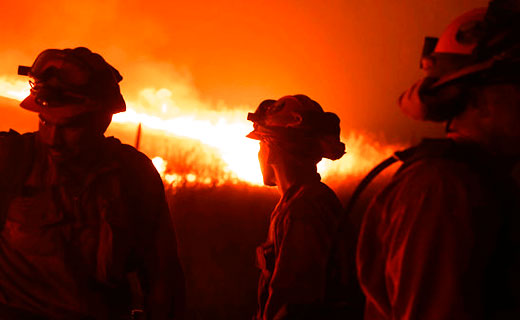
As the country continues to endure the effects of climate change, wildfires are hardly a new phenomenon on the West Coast. For drought-ridden California, however, the blazes have now caused massive destruction and at least one death. And with 700,000 acres burned so far this year, there’s no end in sight for the inferno.
For firefighters and victims, the numbers behind the blazes represent an uphill battle. The largest of the disasters are the Valley fire and the Butte fire, which have burned 67,000 and 71,660 acres, respectively. The former is 15 percent contained, the latter 37 percent, and at least 23,000 people have been displaced by both combined. In total, at least 751 homes have been destroyed. It was the Valley fire that caused one death – Barbara McWilliams, a 72 year-old woman with multiple sclerosis who couldn’t get out of her home, according to fire officials.
The Valley fire, located in Lake County, began on Sept. 12, while the Butte fire, in Jackson and Amador County, started Sept. 9. And these, while the largest and most fearsome, are only two of a dozen currently ripping through the Golden State. Workers fighting the fires hope that rain today might bring some relief. Though an end to the state’s ongoing drought is not yet in the cards, the cool weather system could play a part in further containing some of the blazes.
Veteran firefighter Bob Cummensky, part of the initial team that fought the Valley fire in Middletown, remarked, “It’s such a beautiful area, and it’s changed forever. This [town] is my best friend’s home.” Though he has fought fires for nearly five decades, he said he’s never seen anything of this magnitude. The fire’s expansion in every direction, and the challenging topography across which it has spread, have not made matters easier. “It’s a 100-year fire in a 100-year drought. It goes against everything I’ve ever learned about fire behavior.”
The fire is certainly abnormal; its smoke has even created a rare type of cloud called a pyrocumulus, which was photographed Sept. 11 by climate scientist Peter Gleick and tweeted as he flew past it at 30,000 feet. These clouds also create a new problem, because they can trigger firestorms, which may produce lightning that can, in turn, start another fire. It’s an unpredictable situation that has kept officials on the defensive.
“We’ve had wildfires in California since the beginning of time,” said Mark Ghilarducci, director of the state Office of Emergency Services. “But what we’re seeing now that’s different is the extreme rapid spread of the fires, and extreme volatility.”
Middletown was amongst the hardest-hit areas in Lake County, with phrases like “completely devastated” and “everything’s gone” reverberating throughout the community. And the fire, which has burned far more than just forest land, has a decidedly urban bent: an apartment complex with more than 100 units was reduced to ash; flames licked at power lines and melted street signs; and shells of burned out cars conjured up images of apocalyptic disaster films.
California Gov. Jerry Brown once again tied the problem to climate change, stating, “There is no doubt that we need to de-carbonize our modern economy. We have sharpened what the debate is because there are vast amounts of officials who say it isn’t true. This will smoke it out. Fires are not political. Climate change is not political. It is real. This is serious stuff. Firefighters need to be careful, but so do people. It’s going to get worse.”
Specifically, however, the wildfires were exacerbated by the drought, which in turn was caused by the output of greenhouse gases that are contributing to global warming. The trees killed so far by the drought – of which there were at least 12 million – were more prone to ignite, and a heavy presence of bark beetles, which further decimate trees, helped make conditions that much worse.
Scott Stephens, a fire science professor at UC Berkeley, said forests have also grown denser over the last 100 years, forcing trees to compete for increasingly limited amounts of water and rendering them more susceptible to bark beetle infestations. It also means that when a small fire starts, it spreads from one tree to another more quickly and rapidly spins out of control. “If this drought continues for another two years or longer, I expect this mortality to move throughout the state,” he remarked. “Forests that once burned frequently with low to moderate intensity fires are the most susceptible.”
Joe Casola, deputy director of the University of Washington’s Climate Impacts Group, explained that on the West Coast, this year’s combination of warm winter weather, low snowpack, hot summer, and outbreak of relentless brushfires is “a good preview of what climate models tell us will soon be commonplace. These are the conditions we’re likely to be facing several decades from now and going forward.”
Photo: Firefighters look on as the Valley fire spreads in California. | AP










